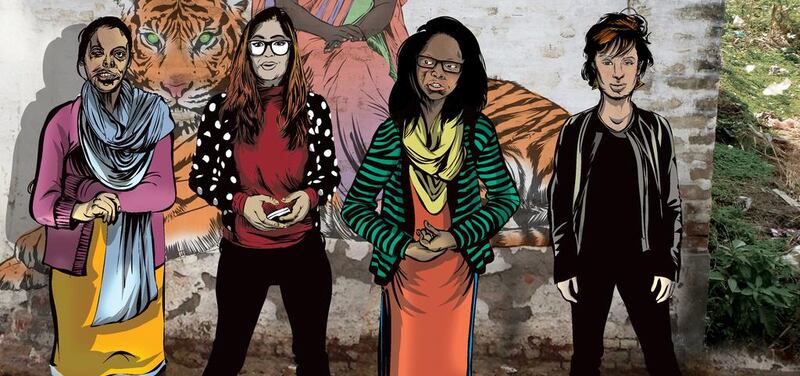In an age when women struggle for positive representation in books and the media, and feminist champions are often marginalised, it is heartening to see the bravery of acid-attack survivors celebrated in a comic book.
Priya's Mirror is the second volume of Indian-American documentary filmmaker Ram Devineni's groundbreaking interactive graphic novel, the first chapter of which, Priya's Shakti, was published in December 2014.
In the follow-up, rape survivor and modern-day Indian superhero Priya joins forces with acid-attack survivors from around the world who are united by their experiences, and their fight against a demon and for better legal protection of their rights.
Like volume one, the new book adds another level of immersion to the story by using augmented reality to bring the story to life and unlock additional story elements. It has its premier today at the New York Film Festival at Lincoln Center, New York City.
Available in English, Hindi, Spanish, Italian and Portuguese, Priya's Mirror was funded by the World Bank's WEvolve global initiative, which aims to change attitudes to gender inequality and violence against women. It was written by Devineni and Indian documentary filmmaker and columnist Paromita Vohra, with artwork by Los Angeles illustrator Dan Goldman.
“Art is all about turning a complex idea into a simple form that will touch people at a very human level,” says Mumbai- based Vohra. She was happy to get involved with the project, she says, because feminist issues are close to her heart – and the prospect of writing her first comic book was exciting.
“I genuinely believe that the feminist approach thinks about ways not just to punish violence, but also break the cycle of violence,” she says.
To this end, the story delves into how perpetrators capable of such horrific actions are created in society.
“We need to address the system that is making people violent,” Vohra adds.
After working to change attitudes towards victims of rape in the first book, Priya this time encounters acid-attack survivors and shows them the “mirror of love”. This is a mystical artefact she receives from the Hindu Goddess Parvati, which allows them to look beyond their scarred faces and see their true selves. It helps them to restore confidence and find the courage to step out into the world and lead a normal life again.
“Everything in the world is only how we look at it,” says Vohra, for whom the mythological tale of Parvati’s mirror has always been an article of faith.
The story of Priya's Mirror revolves around three kinds of wronged people: the acid-attack survivors; Priya, a rape survivor; and the perpetrator of the crime, who was himself abused before turning into a demon.
Vohra points out that all of them direct their anger about what happened to them in different ways.
“The story expresses the importance of righteous anger,” she says.
Vohra salutes the indomitable courage of real-life acid-attack victims and was keen to avoid stereotypes when recounting the personal stories and struggles of survivors.
"We need to start looking at them as having made an extraordinary personal journey and use those stories to understand the larger substance," she says. "In Priya's Mirror, I wanted to talk about the political context, rights and justice, and also of emotions and feelings, all in one place."
Priya's Mirror is free to download – and on show until October 16 at the Walter Reade Theatre's Furman Gallery at the Film Society of Lincoln Centre – in an effort to help ensure that the voices of survivors are heard worldwide.
Every page of the book is supported by additional augmented-reality content that can be accessed using Blippar, a smartphone app.
The most moving content includes videos of Laxmi and Sonia Choudhary, acid-attack survivors from India who talk about their experiences.
Another Indian survivor, Monica Singh, shares the story of her journey from New Delhi to New York, where she leads the Mahendra Singh Foundation, which supports fellow survivors.
Colombian survivor Natalia Ponce de Leon, whose efforts led to the introduction of new legislation in her country, talks about the plight of survivors there.
Her campaign, The Last Mask, which spread around the world, is highlighted, and readers can digitally add a mask like the one she wears to their photos and share the images on social media as a show of support.
Some pages feature pop-up information about Indian mythology and acid attacks, while others feature artwork about the subject.
Vohra believes that art allows us to think about issues differently, and that a comic book such as Priya's Mirror potentially has a very wide reach.
The first volume was honoured by UN Women as a “gender- equality champion” and was downloaded more than half a million times.
“Very few people would know an acid-attack survivor personally,” she says. “They will be able to extrapolate ideas from such books and get talking about gender-based violence.”
• Priya’s Mirror can be downloaded from www.priyashakti.com, and is on display at the Walter Reade Theatre’s Furman Gallery at the Film Society of Lincoln Centre, New York, until October 16
artslife@thenational.ae





